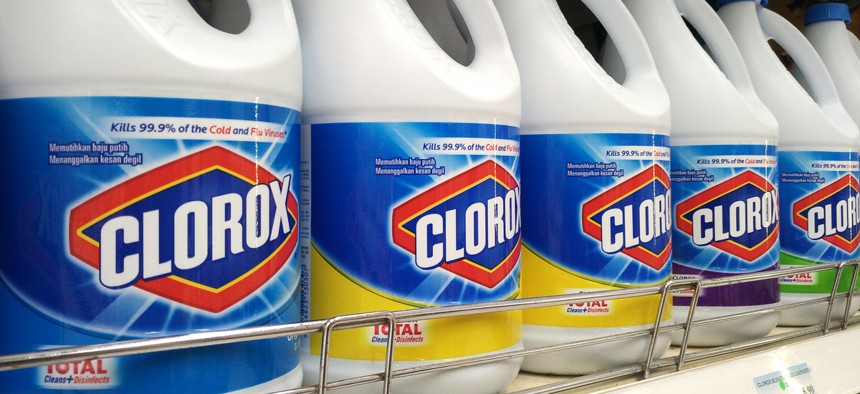Americans are Gargling Bleach to Prevent Coronavirus. (It Doesn't Work.)

Calls to poison control centers spiked in April after President Trump suggested that ingesting or injecting bleach might cure the virus. Shutterstock

Connecting state and local government leaders
Results of a survey commissioned by the CDC found that nearly 40% of respondents had engaged in "high-risk" practices, such as cleaning fruits with bleach solutions or applying household cleaners directly to their skin, in an effort to ward off Covid-19.
To prevent the spread of Covid-19, public health experts recommend wearing a face covering, frequent hand-washing and maintaining social distancing in public places. They don’t recommend gargling soap, rubbing household cleaners on bare skin or washing food with bleach—but a number of Americans are trying those things anyway.
Nearly 40% of respondents in a survey commissioned by the Centers for Disease Control and Prevention said they had intentionally engaged in what the agency classifies as a “high-risk” practice. Most commonly, participants had cleaned fruits and vegetables with bleach (19%) or applied householding cleaners or disinfectants on their bare skin (18%). Other respondents reported misting their bodies with cleaning or disinfectant spray (10%), inhaling vapors from household cleaners or disinfectants (6%) and drinking or gargling “diluted bleach solutions, soapy water and other cleaning and disinfectant solutions” (4%).
“These practices pose a risk of severe tissue damage and corrosive injury and should be strictly avoided,” researchers wrote. “The association between these high-risk practices and reported adverse health effects indicates a need for public messaging regarding safe and effective cleaning and disinfection practices aimed at preventing (Covid-19) transmission in households.”
The report, released Friday, was a follow-up to previous research that found that poison control centers saw a spike in calls related to exposure to household chemicals and disinfectants after the onset of Covid-19.
According to that data, from January through March, 55 poison centers across the country fielded 45,550 calls about exposure to cleaners and disinfectants, a 20.4% increase from the same time period a year before. Some poison control centers reported an additional increase in call traffic in April, after President Donald Trump suggested that ingesting or injecting bleach could be a potential cure for the virus.
To learn more, researchers from the CDC in May surveyed 502 people ranging in age from 18 to 86. Respondents live in every region of the country, though most—38%—reside in the South.
In addition to “high-risk” behaviors, respondents said they had adopted new home hygiene practices after the onset of the pandemic, including 62% of participants who said they were cleaning or disinfecting more often than in previous months.
Kate Elizabeth Queram is a staff correspondent for Route Fifty and is based in Washington, D.C.

NEXT STORY: Majority of Minneapolis City Council Vows to Dismantle City’s Police Force




